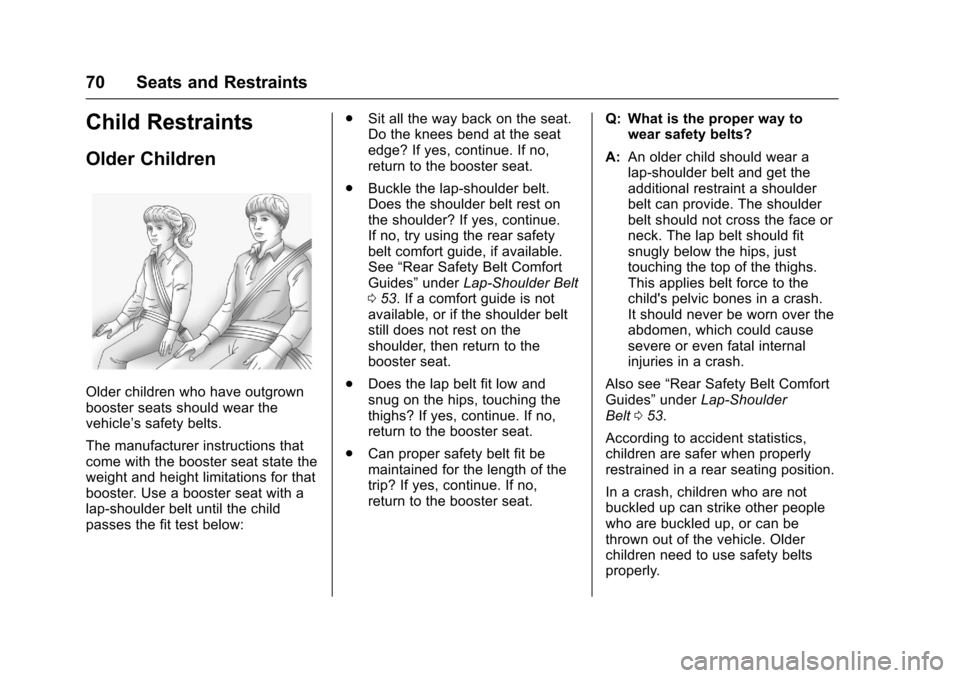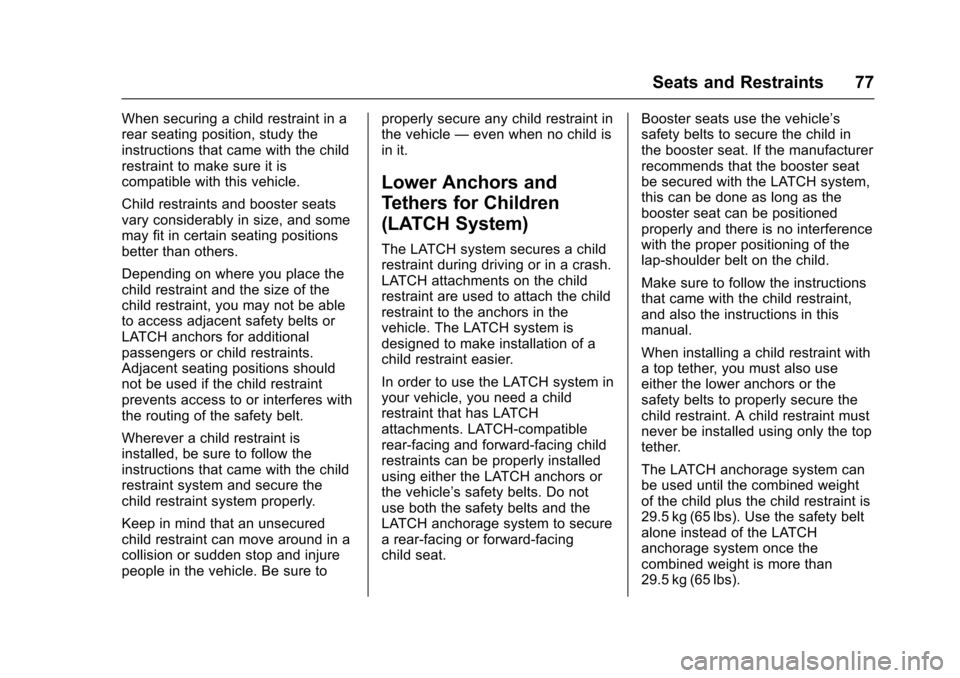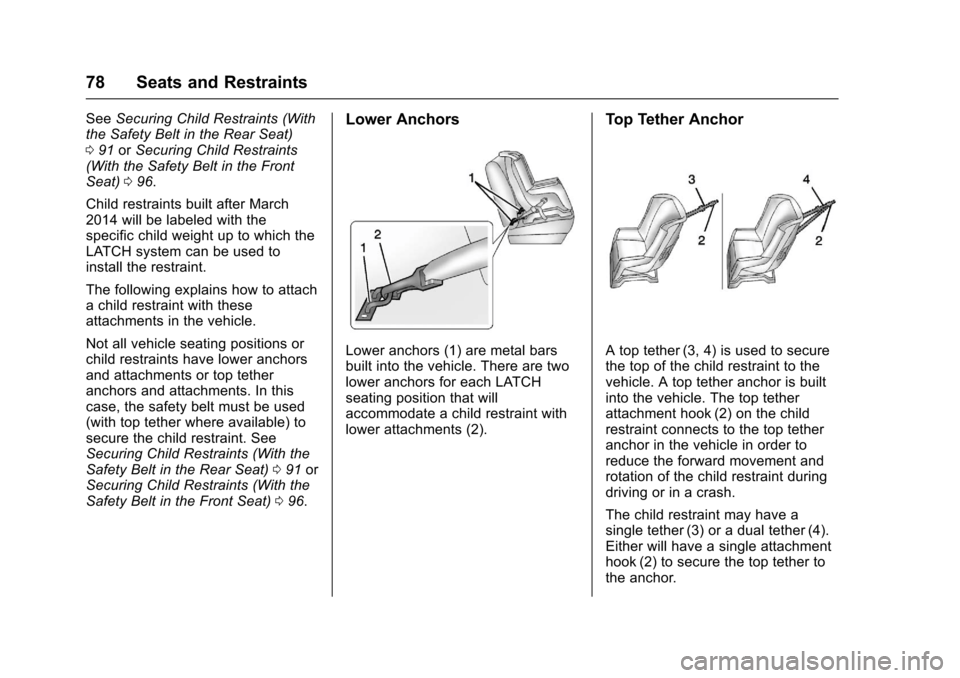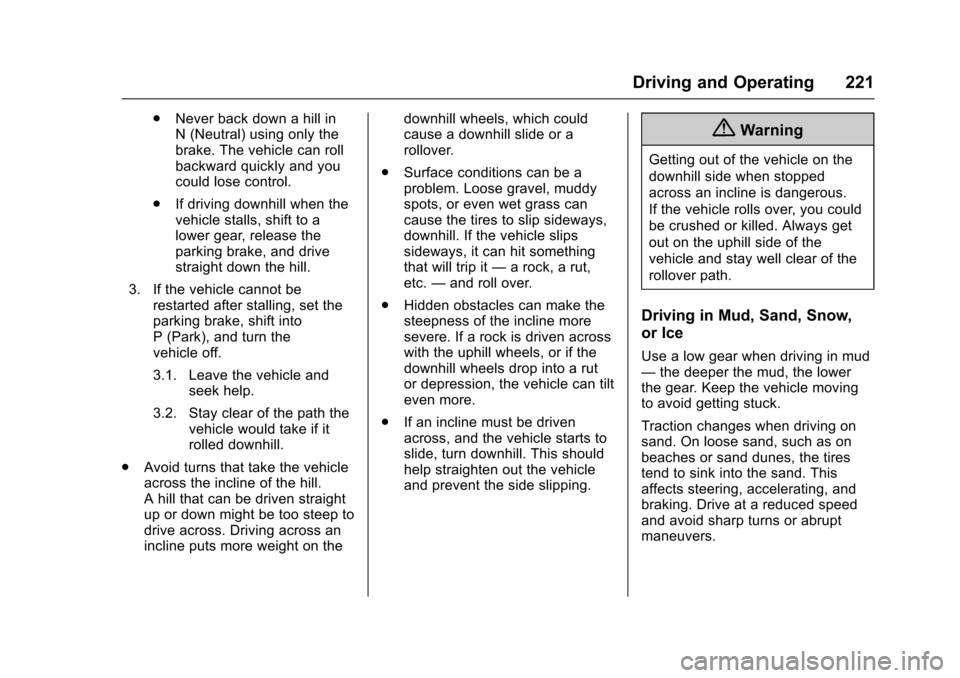2017 CHEVROLET COLORADO weight
[x] Cancel search: weightPage 65 of 419

Chevrolet Colorado Owner Manual (GMNA-Localizing-U.S./Canada/Mexico-10122675) - 2017 - crc - 8/22/16
64 Seats and Restraints
Passenger Sensing
System
The vehicle has a passengersensing system for the frontoutboard passenger position. Thepassenger airbag status indicatorwill light on the overhead consolewhen the vehicle is started.
United States
Canada and Mexico
The words ON and OFF, or thesymbol for on and off, will be visibleduring the system check. When thesystem check is complete, either theword ON or OFF, or the symbol for
on and off, will be visible. SeePassenger Airbag StatusIndicator011 7.
The passenger sensing systemturns off the front outboardpassenger frontal airbag undercertain conditions. No other airbagis affected by the passengersensing system.
The passenger sensing systemworks with sensors that are part ofthe front outboard passenger seatand safety belt. The sensors aredesigned to detect the presence ofaproperlyseatedoccupantanddetermine if the front outboardpassenger frontal airbag should beallowed to inflate or not.
According to accident statistics,children are safer when properlysecured in a rear seat in the correctchild restraint for their weightand size.
Whenever possible, children aged12 and under should be secured inarearseatingposition.
Never put a rear-facing child seat inthe front. This is because the risk tothe rear-facing child is so great,if the airbag inflates.
{Warning
Achildinarear-facingchild
restraint can be seriously injured
or killed if the passenger frontal
airbag inflates. This is because
the back of the rear-facing child
restraint would be very close to
the inflating airbag. A child in a
forward-facing child restraint can
be seriously injured or killed if the
passenger frontal airbag inflates
and the passenger seat is in a
forward position.
Even if the passenger sensing
system has turned off the
passenger frontal airbag, no
system is fail-safe. No one can
guarantee that an airbag will not
deploy under some unusual
circumstance, even though the
airbag is turned off.
(Continued)
Page 66 of 419

Chevrolet Colorado Owner Manual (GMNA-Localizing-U.S./Canada/Mexico-10122675) - 2017 - crc - 8/22/16
Seats and Restraints 65
Warning (Continued)
Never put a rear-facing child
restraint in the front seat, even if
the airbag is off. If securing a
forward-facing child restraint in
the front outboard passenger
seat, always move the seat as far
back as it will go. It is better to
secure child restraints in the rear
seat. Consider using another
vehicle to transport the child
when a rear seat is not available.
If the vehicle does not have a rearseat that will accommodate arear-facing child restraint, arear-facing child restraint should notbe installed in the vehicle, even ifthe airbag is off.
The passenger sensing system isdesigned to turn off the frontoutboard passenger frontal airbag if:
.The front outboard passengerseat is unoccupied.
.The system determines that aninfant is present in a rear-facinginfant seat.
.The system determines that asmall child is present in a childrestraint.
.The system determines that asmall child is present in abooster seat.
.Afrontoutboardpassengertakes his/her weight off of theseat for a period of time.
.The front outboard passengerseat is occupied by a smallerperson, such as a child who hasoutgrown child restraints.
.There is a critical problem withthe airbag system or thepassenger sensing system.
When the passenger sensingsystem has turned off the frontoutboard passenger frontal airbag,the off indicator will light and stay litas a reminder that the airbag is off.SeePassenger Airbag StatusIndicator011 7.
The passenger sensing system isdesigned to turn on the frontoutboard passenger frontal airbaganytime the system senses that aperson of adult size is sitting
properly in the front outboardpassenger seat. When thepassenger sensing system hasallowed the airbag to be enabled,the on indicator will light and stay litas a reminder that the airbag isactive.
For some children who haveoutgrown child restraints, and forvery small adults, the passengersensing system may or may not turnoff the front outboard passengerfrontal airbag, depending upon theperson's seating posture and bodybuild. Everyone in the vehicle whohas outgrown child restraints shouldwear a safety belt properly—whether or not there is an airbag forthat person.
{Warning
If the airbag readiness light ever
comes on and stays on, it means
that something may be wrong
with the airbag system. To help
avoid injury to yourself or others,
have the vehicle serviced right
(Continued)
Page 71 of 419

Chevrolet Colorado Owner Manual (GMNA-Localizing-U.S./Canada/Mexico-10122675) - 2017 - crc - 8/22/16
70 Seats and Restraints
Child Restraints
Older Children
Older children who have outgrownbooster seats should wear thevehicle’ssafetybelts.
The manufacturer instructions thatcome with the booster seat state theweight and height limitations for thatbooster. Use a booster seat with alap-shoulder belt until the childpasses the fit test below:
.Sit all the way back on the seat.Do the knees bend at the seatedge? If yes, continue. If no,return to the booster seat.
.Buckle the lap-shoulder belt.Does the shoulder belt rest onthe shoulder? If yes, continue.If no, try using the rear safetybelt comfort guide, if available.See“Rear Safety Belt ComfortGuides”underLap-Shoulder Belt053.Ifacomfortguideisnotavailable, or if the shoulder beltstill does not rest on theshoulder, then return to thebooster seat.
.Does the lap belt fit low andsnug on the hips, touching thethighs? If yes, continue. If no,return to the booster seat.
.Can proper safety belt fit bemaintained for the length of thetrip? If yes, continue. If no,return to the booster seat.
Q: What is the proper way towear safety belts?
A:An older child should wear alap-shoulder belt and get theadditional restraint a shoulderbelt can provide. The shoulderbelt should not cross the face orneck. The lap belt should fitsnugly below the hips, justtouching the top of the thighs.This applies belt force to thechild's pelvic bones in a crash.It should never be worn over theabdomen, which could causesevere or even fatal internalinjuries in a crash.
Also see“Rear Safety Belt ComfortGuides”underLap-ShoulderBelt053.
According to accident statistics,children are safer when properlyrestrained in a rear seating position.
In a crash, children who are notbuckled up can strike other peoplewho are buckled up, or can bethrown out of the vehicle. Olderchildren need to use safety beltsproperly.
Page 74 of 419

Chevrolet Colorado Owner Manual (GMNA-Localizing-U.S./Canada/Mexico-10122675) - 2017 - crc - 8/22/16
Seats and Restraints 73
Child restraints are devices used torestrain, seat, or position children inthe vehicle and are sometimescalled child seats or car seats.
There are three basic types ofchild restraints:
.Forward-facing child restraints
.Rearward-facing child restraints
.Belt-positioning booster seats
The proper child restraint for yourchild depends on their size, weight,and age, and also on whether thechild restraint is compatible with thevehicle in which it will be used.
For each type of child restraint,there are many different modelsavailable. When purchasing a childrestraint, be sure it is designed to beused in a motor vehicle. If it is, therestraint will have a label saying thatit meets federal motor vehicle safetystandards. The restraintmanufacturer's instructions thatcome with the restraint state theweight and height limitations for aparticular child restraint. In addition,there are many kinds of restraintsavailable for children with specialneeds.
{Warning
To r e d u c e t h e r i s k o f n e c k a n d
head injury in a crash, infants and
toddlers should be secured in a
rear-facing child restraint until age
two, or until they reach the
maximum height and weight limits
of their child restraint.
{Warning
Ayoungchild'shipbonesarestill
so small that the vehicle's regular
safety belt may not remain low on
the hip bones, as it should.
Instead, it may settle up around
the child's abdomen. In a crash,
the belt would apply force on a
body area that is unprotected by
any bony structure. This alone
could cause serious or fatal
injuries. To reduce the risk of
serious or fatal injuries during a
crash, young children should
always be secured in appropriate
child restraints.
Page 78 of 419

Chevrolet Colorado Owner Manual (GMNA-Localizing-U.S./Canada/Mexico-10122675) - 2017 - crc - 8/22/16
Seats and Restraints 77
When securing a child restraint in arear seating position, study theinstructions that came with the childrestraint to make sure it iscompatible with this vehicle.
Child restraints and booster seatsvary considerably in size, and somemay fit in certain seating positionsbetter than others.
Depending on where you place thechild restraint and the size of thechild restraint, you may not be ableto access adjacent safety belts orLATCH anchors for additionalpassengers or child restraints.Adjacent seating positions shouldnot be used if the child restraintprevents access to or interferes withthe routing of the safety belt.
Wherever a child restraint isinstalled, be sure to follow theinstructions that came with the childrestraint system and secure thechild restraint system properly.
Keep in mind that an unsecuredchild restraint can move around in acollision or sudden stop and injurepeople in the vehicle. Be sure to
properly secure any child restraint inthe vehicle—even when no child isin it.
Lower Anchors and
Tethers for Children
(LATCH System)
The LATCH system secures a childrestraint during driving or in a crash.LATCH attachments on the childrestraint are used to attach the childrestraint to the anchors in thevehicle. The LATCH system isdesigned to make installation of achild restraint easier.
In order to use the LATCH system inyour vehicle, you need a childrestraint that has LATCHattachments. LATCH-compatiblerear-facing and forward-facing childrestraints can be properly installedusing either the LATCH anchors orthe vehicle’ssafetybelts.Donotuse both the safety belts and theLATCH anchorage system to securearear-facingorforward-facingchild seat.
Booster seats use the vehicle’ssafety belts to secure the child inthe booster seat. If the manufacturerrecommends that the booster seatbe secured with the LATCH system,this can be done as long as thebooster seat can be positionedproperly and there is no interferencewith the proper positioning of thelap-shoulder belt on the child.
Make sure to follow the instructionsthat came with the child restraint,and also the instructions in thismanual.
When installing a child restraint withatoptether,youmustalsouseeither the lower anchors or thesafety belts to properly secure thechild restraint. A child restraint mustnever be installed using only the toptether.
The LATCH anchorage system canbe used until the combined weightof the child plus the child restraint is29.5 kg (65 lbs). Use the safety beltalone instead of the LATCHanchorage system once thecombined weight is more than29.5 kg (65 lbs).
Page 79 of 419

Chevrolet Colorado Owner Manual (GMNA-Localizing-U.S./Canada/Mexico-10122675) - 2017 - crc - 8/22/16
78 Seats and Restraints
SeeSecuring Child Restraints (Withthe Safety Belt in the Rear Seat)091orSecuring Child Restraints(With the Safety Belt in the FrontSeat)096.
Child restraints built after March2014 will be labeled with thespecific child weight up to which theLATCH system can be used toinstall the restraint.
The following explains how to attachachildrestraintwiththeseattachments in the vehicle.
Not all vehicle seating positions orchild restraints have lower anchorsand attachments or top tetheranchors and attachments. In thiscase, the safety belt must be used(with top tether where available) tosecure the child restraint. SeeSecuring Child Restraints (With theSafety Belt in the Rear Seat)091orSecuring Child Restraints (With theSafety Belt in the Front Seat)096.
Lower Anchors
Lower anchors (1) are metal barsbuilt into the vehicle. There are twolower anchors for each LATCHseating position that willaccommodate a child restraint withlower attachments (2).
Top Tether Anchor
Atoptether(3,4)isusedtosecurethe top of the child restraint to thevehicle. A top tether anchor is builtinto the vehicle. The top tetherattachment hook (2) on the childrestraint connects to the top tetheranchor in the vehicle in order toreduce the forward movement androtation of the child restraint duringdriving or in a crash.
The child restraint may have asingle tether (3) or a dual tether (4).Either will have a single attachmenthook (2) to secure the top tether tothe anchor.
Page 86 of 419

Chevrolet Colorado Owner Manual (GMNA-Localizing-U.S./Canada/Mexico-10122675) - 2017 - crc - 8/22/16
Seats and Restraints 85
{Warning
Do not let anyone ride in the front
passenger seat when a
rear-facing child restraint is
installed in the right rear seating
position. To properly fit the
rear-facing child restraint, the
front seatback will need to be
tilted forward which will not allow
apassengertositproperlyinthe
front outboard passenger seat.
The passenger could be seriously
injured or killed in a sudden stop
or crash.
{Warning
Do not attach a top tether to the
loop near the top of the seatback
and directly behind the seating
position in which the child
restraint is installed in an
extended cab with rear seats. The
top tether will not be able to be
(Continued)
Warning (Continued)
properly tightened. See
instructions below for how to
properly attach a top tether.
Extended Cab Rear Seat CushionExtension
The vehicle is equipped with aheadrest that is used as a seatcushion extension for installation ofchild restraints in the right rear seat.
{Warning
The right rear seat cushion
extension is designed to support
the weight of a child in a child
restraint or booster seat. It is
neither designed nor intended to
support the weight of an adult.
Use the seat cushion extension
only when a child restraint or
booster seat is installed in the
right rear seating position.
When installing a rear-facing childrestraint in the right rear seatingposition, move the front seat all theway forward and tilt the seatbackforward to properly install the childrestraint. SeePower SeatAdjustment046,Seat Adjustment046,andReclining Seatbacks047.When a rear-facing child restraint isinstalled properly, the frontpassenger seat cannot be used.
1. Always install the seat cushionextension in the right rearseating position when installingaforward-facingorrear-facingchild restraint. Also use theseat cushion extension forbooster seats that extend pastthe front edge of the seatcushion.
Page 222 of 419

Chevrolet Colorado Owner Manual (GMNA-Localizing-U.S./Canada/Mexico-10122675) - 2017 - crc - 8/22/16
Driving and Operating 221
.Never back down a hill inN(Neutral)usingonlythebrake. The vehicle can rollbackward quickly and youcould lose control.
.If driving downhill when thevehicle stalls, shift to alower gear, release theparking brake, and drivestraight down the hill.
3. If the vehicle cannot berestarted after stalling, set theparking brake, shift intoP(Park),andturnthevehicle off.
3.1. Leave the vehicle andseek help.
3.2. Stay clear of the path thevehicle would take if itrolled downhill.
.Avoid turns that take the vehicleacross the incline of the hill.Ahillthatcanbedrivenstraightup or down might be too steep todrive across. Driving across anincline puts more weight on the
downhill wheels, which couldcause a downhill slide or arollover.
.Surface conditions can be aproblem. Loose gravel, muddyspots, or even wet grass cancause the tires to slip sideways,downhill. If the vehicle slipssideways, it can hit somethingthat will trip it—arock,arut,etc.—and roll over.
.Hidden obstacles can make thesteepness of the incline moresevere. If a rock is driven acrosswith the uphill wheels, or if thedownhill wheels drop into a rutor depression, the vehicle can tilteven more.
.If an incline must be drivenacross, and the vehicle starts toslide, turn downhill. This shouldhelp straighten out the vehicleand prevent the side slipping.
{Warning
Getting out of the vehicle on the
downhill side when stopped
across an incline is dangerous.
If the vehicle rolls over, you could
be crushed or killed. Always get
out on the uphill side of the
vehicle and stay well clear of the
rollover path.
Driving in Mud, Sand, Snow,
or Ice
Use a low gear when driving in mud—the deeper the mud, the lowerthe gear. Keep the vehicle movingto avoid getting stuck.
Traction changes when driving onsand. On loose sand, such as onbeaches or sand dunes, the tirestend to sink into the sand. Thisaffects steering, accelerating, andbraking. Drive at a reduced speedand avoid sharp turns or abruptmaneuvers.